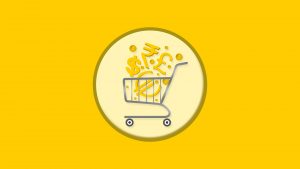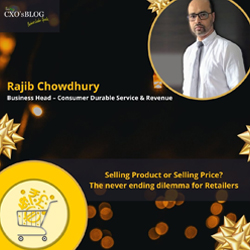Written by: Rajib Chowdhury
About the author: Business Head – Consumer Durable Service & Revenue

The incredible size and spread of our retail industry attracts everyone – from big MNCs to Family owned retail chains to neighborhood traders. Retailing keeps our country healthy and lively. It ensures necessary circulation of money. Retail industry is our largest employer also. We have population, we have demand. But yet, starting a retail business is not that easy. Too many people are struggling it out in this market to stay relevant.
If you are thinking of jumping into a retail venture either as a businessman or as an employee, be ready for the competition. Since competition is unavoidable, it is necessary for you to have something which will differentiate you from the rest. Here comes the most common question – what could be that differentiator?
Easiest way for any retailer or seller is to go for ‘pricing’ option. ‘We provide the best price’ or ‘We are the cheapest’ – these are easy to communicate. It creates the natural flow of customers towards your retail outlet. But the “pricing” game is very difficult to sustain. Remember, the customer is only attracted towards your pricing, not towards your outlet. It hardly creates any bond between the customer and the retail outlet. Soon you will find someone nearby is selling the same thing at lower price. Overnight, you will lose all your customer base.
Is the “price” strategy wrong game to play then? Not really. It depends on which product you are dealing with. If you are dealing with non-MRP driven products like Garments, Home Decor, Furniture, Handicraft etc., then you can afford to. Non-MRP driven product means where the MRPs are not exposed in the market or non-comparable or non-standardized.
“Price” sells automatically, so you save on repeated marketing and other expenses. But you have to invest on the product sourcing. Your sourcing efficiency and knowledge will make you stand out in the crowd. And also prevent the possibility of someone to pop-up with better pricing. This strategy has double benefit, due to your pricing advantage, you will sell more. In turn you will source more, thus creating a better bargain power with your suppliers.
But if you are dealing with products where the MRPs are exposed to market, you have limited option to play with pricing. It will rather jeopardize your business in total. You can only play with better and innovative product. Customer will remember you whenever they want something better, something new. Sourcing efficiency also plays a critical role in this model. An intelligent Mix of established brand and non-branded innovative products are the key.
Established brand products will provide the credibility to your outlet, but will limit your earning margin. That will be taken care by your non-branded innovative products where you can earn much better margin due to less competition. Non-branded innovative products cannot stand on their own unless you earn the trust of the customer. The branded products will help your outlet to build that trust. The non-branded products have to piggyback on your branded products. If you can balance between branded and non-branded product mix, this can be a sustainable strategy.In long run, even you can come out with your own brand, like most of the corporate retail outlets did.
Most difficult scenario is when someone is dealing with only Branded product and those are 100% MRP driven. Like Appliance or TV industry. Your earning is limited by the brand margin set for the product. Hence you cannot play on pricing. Since it is a branded product, there will be no product differentiation also between you and other retailers dealing with the same product.
So what will you do? Since you are tied up by the both product and price, you need to explore benefits/features which are non-tangible in nature, to associate it with your retail outlet. It must create a recall value with the customers. Ideal combination will be benefits with high perceived value but low in cost. If the benefits can self-sustain their cost in long run, then it will be a winning combination.
But it is easier said than done. What can be those benefits or features? I can discuss few, but remember sky is the limit here. It is all about your power and ability to think out of box.
Any benefit driven by intervention ratio is one option. The advantage of this is the cost of benefit gets distributed within many and hence the individual cost becomes lower. The insurance products work on this principle only. You get a coverage of one crore but pay only eight thousand as premium. One can think of extending the product warranty by few months or providing coverage against physical damage of the product and so on. The cost of such benefits are driven by the insurance premium which is low, but for the customer,the perceived or coverage value is high.
There is another proven option, which is “Customer Service”. It creates value to customer and you will get multiple opportunity to remain in touch with your customers. But this needs long term planning and vision. “Customer Service” will be a considerable investment for initial years. But once sustained, it will start generating revenue directly and indirectly, which will subside its own running cost. Retail outlets providing direct service to customers are always perceived as serious and honest by them.
There can be many such options. Retail is all about hitting customer’s mind on regular intervals. It is like cycling against a slope. If you stop paddling, either you will fall or you will go backwards.
If retail is in your mind, study the demography and competition thoroughly, be innovative and plan for long term only.
